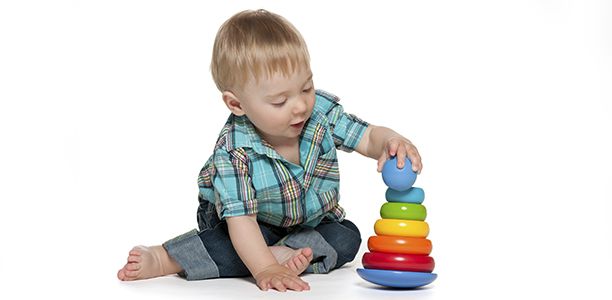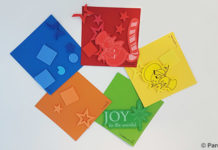Babies develop rapidly in the first few months of life and it is at this very early stage that they begin developing and using their hand and finger muscles. They also start to develop side-strength, control and the hand eye coordination needed to do things like grab with their hands. Giving them toys that rattle or make noises when shaken and playing hands games (e.g. peek-a-boo, pat-a-cake) are amongst the best things you can do to encourage fine motor skills development at this age.
At this early stage of life babies will demonstrate they are developing their fine muscles and their ability to control the use of their fingers by reaching out, for example to grab onto an adult’s finger. They’ll probably also begin to imitate hand actions they observe in adults, for example waving goodbye and clapping their hands.
Babies 0-6 months
Newborns have very little control over or awareness of their bodies. However they rapidly become familiar with their bodies and understand, for example, that their hands are attached to their bodies and can be used to grab things.

At this age they’ll still be using their entire hand (rather than their fingers) to grab things. They begin grabbing and holding objects from about four months of age using crude palmar grasp, that is resting the object on the little finger side of the palm and curling their fingers (but not their thumb) around the object. From about five months most babies have developed palmar grasp. It is similar to crude palmar grasp in that the fingers but not the thumb curl around the object, but the object is stabilised on the middle of the palm. In the first six months of life the hand control and grasps your baby develops and will allow them to do things like:
- Reach out and swipe their arms to grab for an object dangling in front of them.
-

Palmar grasp Grasp an object when it is placed in their hand.
- Grab and hold onto and object for a short period of time, for example hold onto a rattle. They’ll be interested in rattles and other toys that make noises when moved, as well as body parts that are small enough for them to grab including their own toes and your fingers.
- Play with objects of different sizes.
Babies 6-12 months

Babies continue to strengthen their hands and develop their ability to grasp objects. Between six and seven months of age most babies begin holding objects using radial palmar grasp. They use the radial (index finger) side of the palm to stabilise the object while curling their middle and index fingers around it to prevent it from falling. However it is not until about eight months of age that they begin grasping with their thumb, initially by using it along with the index and middle fingers to rake objects into their palm.
Most babies develop inferior pincer grasp in which the object is grasped between the pad of the thumb and the side of the index finger, at around the same time they begin raking objects into their hands.

After a couple of months (usually between 10-12 months of age) they develop a more advance pincer grasp, clasping objects between the pad of the thumb and the pads of the index and middle fingers.
Between 6-12 months of age babies are usually able to use their developing finger strength and control to:
- Reach for and grasp an object using only one hand. After about eight months of age they will probably also enjoy throwing them down again.
-

Pincer grasp Hold and shake objects like rattles and keys;
- Transfer objects from one hand to another. At this age babies will also enjoy looking at the objects they pick up and will usually try and transfer just about everything to their mouths as well.
- Hold two objects, one in each hand.
- Pick up small objects using pincer grip (grasping an object between the thumb and index finger);
- Bang toys or other objects together and scrunch up paper. They will enjoy hearing the noises their actions make as they are coordinating not only their hands and eyes at this age, but also their sense of hearing.
- Clasp their hands together.
- Follow a moving person with their eyes. Although it involves the eyes and the hands, this is an important part of fine motor development because fine motor tasks rely on babies and children having the ability to coordinate the movements of their hands with what their eyes see.
- Self-feed simple finger foods like rusks and attempt to self-feed using appropriate, baby-size utensils like spoons. If using a spoon they will probably clench it in their fist and are likely to miss when they try and bring the spoon up to their mouth. At this age they’ll find it easier to self-feed with finger food like baby rusks. They should be able to hold an manipulate their own bottle.
Babies 12-18 months

Babies usually develop a neat pincer grasp after 12 months of age however babies with more advanced finger skills may develop this grasp as early as nine months. Neat pincer grasp is similar to pincer grasp in that objects are held using only the thumb and index finger. However instead of using the index finger pad, the index finger tip is used to grasp the object. Babies also develop early writing grasps (grasps used to hold and manipulate pencils, crayons and other writing implements) at this age.
Between 12-18 months babies can typically:
-

Radial cross palmar grasp Scribble with a fat pencil or crayon held in their fist. This is the earliest form of writing grasp. The writing implement is held vertically. Depending on whether the thumb is up or down this fisted grip is referred to as either radial cross palmar grasp (thumb down) or palmar supinate grasp (thumb up). When using the entire fist babies often hold the pencil in the middle rather than near the tip. They usually hold their hand up, placing only the pencil on the paper and not the side of their hand. Babies have not yet developed the ability to grasp a pencil correctly.
- Turn the pages of a board book (thick pages), typically turning two to three pages at a time.
-

Palmar supinate grasp Place objects on a peg board or peg game.
- Turn knobs and buttons.
- Feed themselves efficiently using their fingers and attempt to self-feed using utensils like a baby-sized fork.
- Drink from a cup without a lid.
- Look and point at an object they want to touch which is out of reach.
- Remove toys, blocks or other objects from a box or bin and put them back in.
Links
 |
Download a checklist of developmental milestones for babies. |
 |
To read more about fine motor skills and development in other age groups, visit Fine Motor Skills. |
References
- Virginia Early Childhood Development Alignment Program. Milestones of child development- A guide to young children’s learning and development from birth to kindergarten. 2009 (cited 12 May 2014). Available from: (URL Link)
- Community Childcare Cooperative Ltd (NSW). Development Milestones and the Early Years Learning Framework and the National Quality Standards. Australian Government Department of Education, Employment and Workplace Relations. 2012 (cited 5 May 2014). Available from: (URL Link)
- South Carolina Education Office of Early Childhood Education. Good Start Grow Smart- South Carolina Early Learning Standards for 3, 4 and 5 year old children. 2007 (cited 5 May 2014) Available From: (URL Link)
- South Carolina Education Office of Early Childhood Education. South Carolina Infant and Toddler Guidelines. 2010 (cited 20 February 2015) Available From: (URL Link)
- Owens Supporting children’s development- fine motor skills. Putting Children First. Issue 28. 2008. National Childcare Accreditation Council. (Full Text)
- Andrews General Categories of Fine Motor Development. Michigan State University Extension. 2014 (cited 28 March 2014). Available from: (URL Link)
- Columbia Developmental Progression of the Grasp. Undated (cited 4 September 2014). Available from: (URL Link)
- Eastern Kentucky University- Occupational Therapy. Writing Grasps. 2011 (cited 4 September 2014). Available from: (URL Link)
- The Early Childhood Technical Assistance Center. ND Early Childhood Outcomes Process Age Expectation Development Milestones. 2010 (cited 3 November 2014). Available from: (URL Link)



 (8 votes, average: 4.50 out of 5)
(8 votes, average: 4.50 out of 5) 






